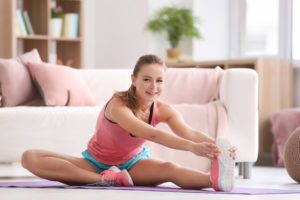
Are you ready to get into top physical shape at home? Then, it’s time to put on your fitness trainer cap and learn to design your own workout sequence. Fortunately, it’s not hard to do You can divide a workout sequence into four distinct stages. Let’s look at each one and why it’s important.
Dynamic Warm-up
Don’t skip the warm up! Never start a workout with cold muscles. The warm-up is designed to raise your core body temperature and get the blood flowing to your muscles before you start working them. The increased blood flow improves the pliability of muscles and gives them more flexibility. A dynamic warm-up also prepares your heart, nervous system for the exercise to come and gets you in the mood to workout.
At one time, it was popular to make static stretching part of the warm-up, but some research shows this can reduce the power output of a muscle as well as reduce exercise performance. So, a dynamic warm-up is what fitness trainers recommend. This type of warm-up moves the muscles you’ll be working in a dynamic manner rather than holding a muscle static and stretching it.
To begin a dynamic warm-up, start with a few minutes of light cardio exercise, like jogging in place, jumping jacks, high knees, or butt kicks. The goal isn’t to get cardiovascular benefits but to slowly increase your heart rate and body temperature. Keep the intensity low. You should easily be able to talk in complete sentences.
After a few minutes, do some leg swings, front kicks, walking lunges, and alternating side lunges. This sequence should cover your lower body. For the upper body, do a series of arm swings, punches, arm crossovers, shoulder circle shrugs.
Length of time:
5 to 10 minutes. If you’re working out later in the day when your body is warm, 5 minutes may suffice. If it’s first thing in the morning, cold or if you feel stiff, 10 minutes is more appropriate.
Skill Training Phase
Now that your muscles are warm, it’s time to get to the “meat” of the workout. These are the exercises you’ll do to increase your fitness level over time. If you’re training at home, you can build strength, muscle endurance, and muscle size using only body weight exercises.
First, decide how many days per week you plan to train. If you can only train two days per week, you’ll want to work your entire body in a single session, including upper body, lower body, and core. If you can train 3 or 4 days per week you can set up a split routine. Do lower body and core during one session and upper body in a separate session and alternate back and forth between upper and lower body exercises at each session. Here are some of the exercises you can choose:
Upper Body Bodyweight Exercises:
- Push-up and push-up variations.
- Pull-ups and chin-ups
- Triceps Dips
- Lower Body Bodyweight Exercises:
- Deep squats
- Forward, lunges, backward lunges, and side lunges, Bulgarian split squats
- Glute bridges
- Hip Thrusts
- Donkey kicks
- Calf raises
Core:
- Planks and plank variations
- Crunches and variations on crunches (stick more to planks if you have back issues)
- Leg Raises
- Bird dogs
- Supermans
- Dynamic Exercises for Cardio Benefits:
- Squat jumps
- Plyo lunges
- Burpees
- Mountain climbers
If you’re training lower body and core, pick 3 exercises from the lower body exercise group and three from the core group. For each exercise, do as many reps as you can until it’s hard to complete another rep using good form. Rest for 2 minutes. Do another set. Aim for 3 sets total. Do the same for the upper body on days that you work your upper body.
What about the dynamic exercises on the list? You can do these exercises that boost your heart rate during a separate training session or in between other bodyweight exercises. If you do them between exercises, the dynamic nature of these movements will keep your heart rate up for additional cardiovascular benefits.
Length of time: 45 minutes to an hour
Maintain Conditioning Phase
To keep making fitness gains, you must continue to place an additional challenge on your body. This is the principle of progressive overload, the idea that you must incrementally increase the challenge to force your body to adapt. When you’re working with weights, you can do this by increasing the weight. With bodyweight exercises, you can overload the muscles by increasing the number of reps, by increasing the number of sets or by adding more exercises to your current workout. Another option is to train more frequently. This will increase the total number of sets you do on a weekly basis. But, be sure to rest the muscles you just worked for at least 48 hours.
Also, you can do more challenging versions of body weight exercises you’re currently doing. For example, you can make push-ups harder by elevating your feet on a bench or by doing variations like plyo push-ups or triangle push-ups. There are tons of push-up variations to choose from! The same goes for planks.
If you continue to train without adding progressive overload, you’ll maintain your current level of fitness but will eventually reach a plateau where you stop making further gains. If you’ve built up a certain level of fitness and just want to maintain it, this may work for you.
Cool-Down Phase
The cool-down is designed to bring your body temperature down slowly and re-equilibrate blood flow. When you exercise, blood diverts to the muscles you’re working and away from organs, like your digestive tract that doesn’t need it.
The cool-down helps restore blood flow to vital organs like your brain. If you suddenly stop exercising without cooling down, you may feel lightheaded or dizzy as blood flow hasn’t is still directed toward your working muscles and your brain feels the shortfall. So, it’s important to reduce exercise intensity slowly and not stop suddenly.
If you’ve just done exercises that boost your heart rate, like mountain climbers, a light jog will bring your heart rate down gradually. Include some of the dynamic movements you did during the warm-up, such as leg and arms swings, in the cooldown as well.
Now that your workout is over, static stretching helps lengthen the muscle you’ve just worked. Include some of these at the end of a cooldown, especially if you have muscle groups prone toward tightness. Borrow from yoga and include downward and upward-facing dogs in your cooldown routine. Once you’ve finished cooling down, don’t forget to hydrate!
Length of time: 5 to 10 minutes
Conclusion:
Now you have a better idea of how to structure your workouts when you train at home. Be sure to give yourself a full day of rest each week!
